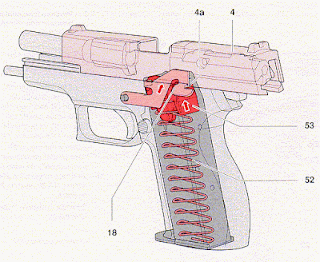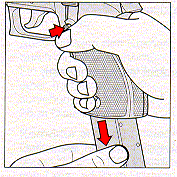Senjata api atau pistol yang sering di tenteng oleh polisi untuk menghadapi penjahat tentu sering kita lihat. Nah untuk mengetahui bagaimana cara kerja pistol pak polisi bisa menggedor penjahat berikut ulasannya.
Secara umum pistol bekerja secara mekanik untuk mendorong peluru. Ledakan peluru inilah yang mendorongnya untuk melesat keluar dari larasnya.
Setelah magazine telah di isi peluru dan di pasang ke pistol, slide ditarik (dikokang). Saat slide ditarik recoil spring akan ikut tertarik dengan mekanisme mekanik peluru akan di dorong ke kamar peluru. Peluru yang ada di dalam magazine didorong keatas oleh spring magazine sehingga peluru tersusun rapi dalam magazine.
Untuk menembak, pengguna pistol tinggal menekan pemicu (trigger) dan firing pin akan menekan pangkal peluru ssehingga peluru meledak. Daya ledakan inilah yang melesatkan peluru keluar lewat laras pistol.
Bagian-bagian senjata genggam (pistol)
- Barrel
- Recoil spring
- Bullet (peluru) di dalam kamar peluru
- Slide
- Breech block
- Pelatuk (hammer)
- Magazine Spring
- Tempat peluru (magazine)
- Pemicu (trigger)
Berikut ini teks dalam bahasa inggis,
Sumber: cybershooter
How does a firearm work?
The following illustrations and description show how a SIG-Sauer P225 9mm semi-automatic pistol work. There are dozens of different operating methods for firearms, but the basic principle of all is the same, the firearm must be loaded, the action cocked for firing, and the firing pin must strike the primer of the cartridge for it to fire:
1) A magazine is loaded with ammunition, and then inserted into the pistol until the magazine release button's stop is engaged (43).
2) The slide (4) is then pulled back, which cocks the hammer (29), and is then released, and is pushed forward by the recoil spring (3). A round of ammunition (P) is stripped from the magazine by the breech block (9) and is fed into the barrel's (1) chamber. The next round in the magazine is forced up by the magazine spring (52).
3) With the firearm now loaded, the trigger (20) can be pulled, which draws forward the trigger bar (22). This has the effect of pivoting the safety lever (28) forward which raises the firing pin safety block (13) allowing the firing pin (11) to move. At the same time, the trigger bar pulls forward the sear (24) from the notch (29a) on the hammer (29), releasing the hammer which is pushed forward by the main spring (34) and hammer strut (33), so that it strikes the rear of the firing pin (11) which hits the primer of the round of ammunition (P) causing it to fire.
4) After the round is fired, the force of the combustion while driving the bullet out of the barrel also forces the empty cartridge case backward, which is called "blowback". This thrusts the slide (4) to the rear. The safety lever (28) and firing pin safety block (13) are separated activating the firing pin safety block. A protrusion on the top of the trigger bar (22) resting in a recess in the slide is forced downward as the slide moves rearward, forcing the trigger bar downward and disengaging it from the safety lever (28). As the slide travels rearward, it takes the barrel with it, until the barrel is stopped by the locking insert (17) which tilts it down and away from the slide.
5) As the slide continues its rearward travel, the sear spring causes the sear (24) and safety lever (28) to return to their original positions. The empty case (H) is extracted by the extractor claw (10) mounted in the slide and upon striking the nose of the ejector on the slide catch lever is ejected out of the ejection port in the slide. As the slide (4) recoils up to its stop, it cocks the hammer (29) which is caught in its notch (29a) by the sear (24). The slide is propelled forward by the recoil spring (3), and the next round is fed into the chamber of the barrel (1) as the slide locks up with the the barrel again. The pistol is now ready to fire again.
6) After the last round is fired, the slide (4) travels rearward and is held in the rearward position by the slide release lever (18) which is forced upward by the action of the magazine spring (52) and magazine follower (53). The lever is forced into the slide release notch (4a) on the slide. The empty magazine is ejected by pressing the magazine release button, and a fresh loaded magazine can be inserted. The gun is then made ready to fire by pressing down on the slide release lever (18) which strips a round off the top of the magazine and into the barrel's chamber.









